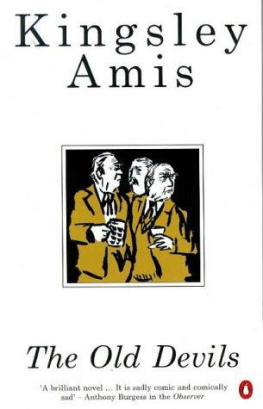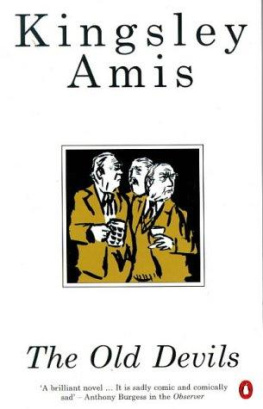
KINGSLEY AMIS (19221995) was a popular and prolific British novelist, poet, and critic, widely regarded as one of the greatest satirical writers of the twentieth century. Born in suburban South London, the only child of a clerk in the office of the mustard-maker Colmans, he went to the City of London School on the Thames before winning an English scholarship to St. Johns College, Oxford, where he began a lifelong friendship with fellow student Philip Larkin. Following service in the British Armys Royal Corps of Signals during World War II, he completed his degree and joined the faculty at the University College of Swansea in Wales. Lucky Jim, his first novel, appeared in 1954 to great acclaim and won a Somerset Maugham Award. Amis spent a year as a visiting fellow in the creative writing department of Princeton University and in 1961 became a fellow at Peterhouse College, Cambridge, but resigned the position two years later, lamenting the incompatibility of writing and teaching (I found myself fit for nothing much more exacting than playing the gramophone after three supervisions a day). Ultimately he published twenty-four novels, including science fiction and a James Bond sequel; more than a dozen collections of poetry, short stories, and literary criticism; restaurant reviews and three books about drinking; political pamphlets and a memoir; and more. Amis received the Booker Prize for his novel The Old Devils in 1986 and was knighted by Queen Elizabeth II in 1990. He had three children, among them the novelist Martin Amis, with his first wife, Hilary Anne Bardwell, from whom he was divorced in 1965. After his second, eighteen-year marriage to the novelist Elizabeth Jane Howard ended in 1983, he lived in a London house with his first wife and her third husband.
MICHAEL DIRDA is a longtime book columnist for The Washington Post and the author, most recently, of Classics for Pleasure and the 2012 Edgar Awardwinning On Conan Doyle.
OTHER BOOKS BY KINGSLEY AMIS PUBLISHED BY NYRB CLASSICS
The Alteration
Introduction by William Gibson
Lucky Jim
Introduction by Keith Gessen
The Old Devils
Introduction by John Banville
THE GREEN MAN
KINGSLEY AMIS
Introduction by
MICHAEL DIRDA
NEW YORK REVIEW BOOKS

New York
THIS IS A NEW YORK REVIEW BOOK
PUBLISHED BY THE NEW YORK REVIEW OF BOOKS
435 Hudson Street, New York, NY 10014
www.nyrb.com
Copyright 1969 by Kingsley Amis
Introduction copyright 2013 by Michael Dirda
All rights reserved.
First published in Great Britain in 1969 by Jonathan Cape
Cover image: Eric Hanson
Cover design: Katy Homans
The Library of Congress has cataloged the earlier printing as follows:
Amis, Kingsley.
The green man / by Kingsley Amis ; introduction by Michael Dirda.
p. cm.
ISBN 978-1-59017-616-0 (alk. paper)
1. Middle-aged menFiction. 2. DeathPsychological aspectsFiction. 3.
Ghost stories. 4. Black humor. I. Title.
PR6001.M6G7 2012
823'.914dc23
2012036616
eISBN 978-1-59017-636-8
v2.0
For a complete list of books in the NYRB Classics series, visit www.nyrb.com or write to:
Catalog Requests, NYRB, 435 Hudson Street, New York, NY 10014
Contents
Introduction
[This essay avoids plot spoilers and may be safely read by those new to the novel.]
Two ingredients most valuable in the concocting of a ghost story are, to me, the atmosphere and the nicely managed crescendo. I assume, of course, that the writer will have got his central idea before he undertakes the story at all. Let us, then, be introduced to the actors in a placid way; let us see them going about their ordinary business, undisturbed by forebodings, pleased with their surroundings; and into this calm environment let the ominous thing put out its head, unobtrusively at first, and then more insistently, until it holds the stage. It is not amiss sometimes to leave a loophole for a natural explanation; but, I would say, let the loophole be so narrow as not to be quite practicable.
M. R. J AMES
Kingsley Amiss The Green Man was first published in 1969, just as the great 1970s boom in horror fiction was about to begin. Ira Levins Rosemarys Baby had already appeared in 1967, and was followed by William Peter Blattys The Exorcist (1971), Thomas Tryons The Other (1971), Stephen Kings Carrie (1974), and Peter Straubs Ghost Story (1979). The enormous popularity of these novels, and others, made clear what shouldnt have been forgottenthat the supernatural tale can be a moral tale, almost by its very nature compelled to address our unacknowledged desires and our most universal fears.
Amis himself particularly admired M. R. James (18621936), whose various ghost stories of an antiquary stand as classics of an English tradition of relatively restrained supernatural fiction. In Jamess work the dead past reaches out into the presentwith a vengeance. In anthology classics such as Canon Alberics Scrapbook and Casting the Runes overly inquisitive dons discover a curious artifact or violate some ancient prohibition and thus bring down upon themselves the unwelcome attention of revenants and demons. For example, Professor Parkins, on holiday, strolls along a beach and almost literally stumbles upon the ruins of a Templar preceptory. There among its crumbling tombstones heunfortunately for himmakes a small discovery:
It was of bronze, he now saw, and was shaped very much after the manner of the modern dog-whistle; in fact, it wasyes, certainly it wasactually no more nor less than a whistle. He put it to his lips.... He blew tentatively and stopped suddenly, startled and yet pleased at the note he had elicited. It had a quality of infinite distance in it, and, soft as it was, he somehow felt it must be audible for miles round.
Amis included Oh, Whistle, and Ill Come to You, My Lad in The Amis Story Anthology as one of his favorite short stories. Everything builds to this moment when Parkins blows the whistle and then gradually realizes that he is no longer alone in his hotel room. In general, Jamess eerie tales are highly atmospheric, leading up to a single short, sharp shock.
The supernatural novel, by contrast, readily tends to become a journey into the self. Henry Jamess The Turn of the Screw dwells on its protagonists psychological state; Walter de la Mares The Return examines the nature of human identity; Algernon Blackwoods The Centaur takes up the possibility of spiritual transcendence. There is, of course, a more visceral tradition too. For example, Dennis Wheatleys occult thrillers, such as The Devil Rides Out and To the DevilA Daughter, are pulp adventure stories built around Satanism, possession, and sexual threat.
Amiss The Green Man draws on all these traditions.
Reticence may be an elderly doctrine to preach, yet from the artistic point of view I am sure it is a sound one. Reticence conduces to effect, blatancy ruins it, and there is much blatancy in a lot of recent stories. They drag in sex too, which is a fatal mistake; sex is tiresome enough in novels; in a ghost story, or as the backbone of a ghost story, I have no patience with it.
M. R. J AMES
While confirmed bachelor Monty James may have had no patience with sex in a ghost story, Amis makes it central to The Green Man. Seduction, of several sorts, suffuses the narrative, imbues it, at times, with an almost pornographic fascination.


















